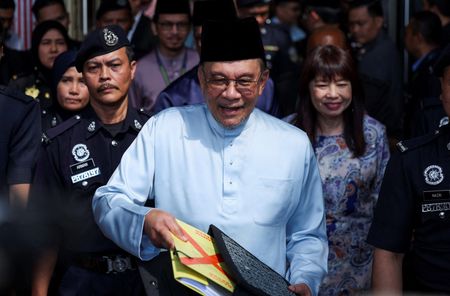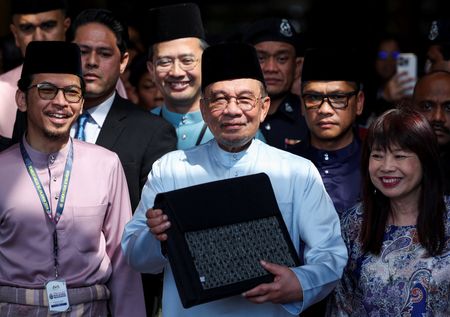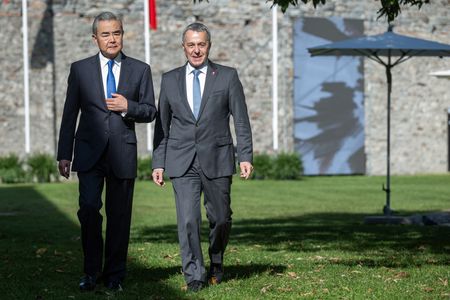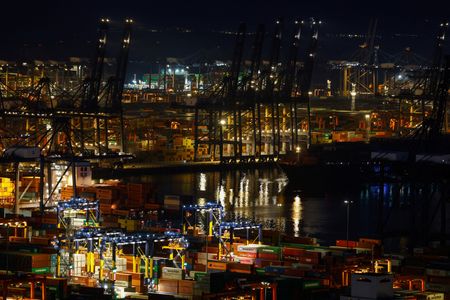By Rozanna Latiff, Danial Azhar and Ashley Tang
KUALA LUMPUR (Reuters) -Malaysia said on Friday it plans to boost tax collection and strengthen social protection systems next year, as it looks to bolster government revenue amid external uncertainties.
Speaking in parliament, Prime Minister Anwar Ibrahim announced a budget of 470 billion ringgit ($111.40 billion) for 2026, a record figure that includes investments from some state-linked companies and statutory bodies.
The 2026 spending plan was revised sharply upwards from the 419.2 billion ringgit proposed in a government report just ahead of Anwar’s speech on Friday.
Malaysia has maintained steady growth even though its exports have been hit by changes in U.S. tariffs, but it needs to boost revenues to reduce its deficit and pursue the economic development goals unveiled in a five-year plan in July.
“We choose the winding, difficult path of reform, strict fiscal discipline and institutional strengthening, as the only path that ensures the nation is saved in the long run,” Anwar said.
NEW CARBON LEVY, HIGHER SIN TAXES
Since taking power in 2022, Anwar has introduced measures to bolster the government’s coffers, including a minimum wage hike, an expanded sales tax and removing petrol and diesel subsidies for some segments of the population.
On Friday, Anwar said the government would go ahead with a proposed carbon tax from next year, starting with the iron, steel and energy sectors.
It would also raise excise duty rates on alcoholic beverages and tobacco from November, and fully implement e-invoicing next year to ensure better tax compliance, he said.
The measures come as Malaysia looks to reduce its reliance on oil-based income. State energy firm Petronas, a significant contributor to government revenues, is expected to pay a dividend of 20 billion ringgit in 2026, its lowest since 2017, according to fiscal and economic outlook reports released alongside Friday’s budget.
Anwar said his government anticipates savings of 15.5 billion ringgit annually from its subsidy reforms, aimed at removing blanket subsidies and replacing them with a system that will directly help the needy.
The government would focus on spurring development in the semiconductor, energy transition, and digital sectors, including 5.9 billion ringgit earmarked for artificial intelligence research and development, Anwar said.
Malaysia’s sovereign wealth fund Khazanah will also look to develop downstream activities in the rare earths sector through international collaborations, he said.
Reuters reported exclusively last week that the government was in talks with China on rare earths processing, and Khazanah would partner with a Chinese firm to build a refinery in Malaysia.
DEFICIT REDUCTION ON TRACK
Amarjeet Singh, the ASEAN tax lead at Ernst & Young, said the government’s tax-to-GDP ratio would increase to 17.4% in 2026 from 12.6% in 2025 under the latest measures, including those first introduced in the past two years such as e-invoicing.
“All of this combined is facilitating these outcomes… which we will see the full impact in 2026,” he said.
OCBC senior ASEAN economist Lavanya Venkateswaran described the budget as “a steadying of the fiscal ship”, with the government balancing various policy priorities in its fiscal consolidation efforts.
The government said it was on track to narrow its fiscal deficit to 3.5% of gross domestic product next year, with a medium-term deficit target of 3% by 2028.
Revenue was seen rising to 343.1 billion ringgit in 2026, while spending on subsidies and social assistance was projected to fall by 14.1% to 49 billion ringgit in 2026, the reports said.
Economic growth was forecast at 4% to 4.5% in 2026, amid trade and tariff uncertainties. The United States has imposed a 19% tariff on most shipments from Malaysia.
Malaysia’s headline inflation rate was seen at 1.3% to 2% in 2026, the reports said.
($1 = 4.22 ringgit)
(Reporting by Rozanna Latiff, Danial Azhar and Ashley Tang; Editing by David Stanway and Susan Fenton)











